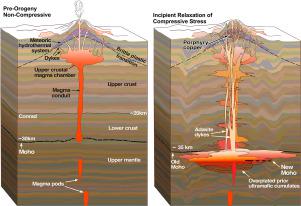Earth-Science Reviews ( IF 10.8 ) Pub Date : 2021-07-20 , DOI: 10.1016/j.earscirev.2021.103744 Robert R. Loucks 1

|
Arc-basaltic melts of typical hydration state (≥ 2 wt% H2O) are buoyant relative to all common crustal igneous rock types and may pass adiabatically from a mantle source through continental crust directly to shallow depths or volcanic vents without significant crystallisation in transit. Basalts are the most common eruptive rocks on continents. So why is the average bulk composition of continental crust “andesitic”, and why is continental crust vertically zoned with “basaltic” compositions at the bottom? In non-compressive segments of continent-margin magmatic belts, the frequency mode for eruptive and hypabyssal (aphanitic groundmass) rocks is ~50 wt% SiO2, and whole-rock Sr/Y falls with rising SiO2. In orogenically deforming segments of continent-margin magmatic belts, the frequency mode of eruptive and hypabyssal rocks is ~60 wt% SiO2, and Sr/Y rises with rising SiO2. Horizontal compression inhibits ascent of buoyant magmas by dyke propagation. Typical values of orogenic horizontal deviatoric stress (~10–30 MPa) can exceed the magma buoyancy force driving dyke propagation and can trap kilometres-thick sills of buoyant magma at all crustal depths. As horizontal compressive stress increases during orogeny, resistance to dyke propagation increases, so more advanced chemical differentiation is achieved at deeper crustal levels. The temperature of fluid-undersaturated country rock at the arc Moho typically is higher than the magma's wet solidus temperature, so residual felsic melts cannot freeze by conductive heat loss to country rocks. Thermally “immortal” residual granitoid magmas may remain stored in Moho-vicinity stress traps as long as strong orogenic compressive stress lasts—5-10 million years or more—and experience multiple replenishments by basaltic melt from the mantle. Ultramafic crystal cumulates produced near the Moho are seismically indistinguishable from regional mantle and are included in the mantle composition inventory, leaving a biased composition inventory of continental crust above the seismic Moho. The volcanic-to-plutonic mass ratio in arc segments is a sensitive function of the tectonic stress regime. Rates of trans-crustal magma transmission should not be misinterpreted as arc magma production rates. “High-flux” pulses of granitoid magmatism in the upper crust tend to substantially lag plate-kinematic indicators of magma production rates in the mantle. Episodes of high-flux granitoid magmatism in the upper crust occur as orogenic compressive stress wanes from peak values, permitting escape of buoyant magmas from long-term storage in stress traps in the deeper crust (or uppermost mantle). Orogenic collapse in “over-thickened” orogens begins at the laterally unconfined highest elevations, and propagates slowly downward, successively tapping stress-trapped magma reservoirs having higher Sr/Y. Whole-rock Sr/Y at 60–70 wt% SiO2 is a better proxy for tectonic stress than for crustal thickness. During fractional crystallisation in intermittently replenished stress traps near the Moho, thermally immortal residual granitoid melts evolve to high (“adakitic”) Sr/Y and exceptional inheritances of dissolved H2O, SO3, and Cl, which endow them with magmatic-hydrothermal copper-ore-forming capability when such melts escape to shallow depths as orogenic stress begins to wane from peak values at Moho-vicinity depths. Improved strategies in the search for porphyry copper ore deposits emerge from understanding the igneous petrogenesis.
中文翻译:

造山带构造应力对浮力岩浆的深层包裹:其在大陆地壳、埃达克岩和斑岩铜矿床中的作用
典型水合状态(≥ 2 wt% H 2 O)的弧形玄武岩熔体相对于所有常见的地壳火成岩类型来说是有浮力的,并且可以从地幔源绝热地穿过大陆地壳直接到达浅层或火山口,在运输过程中没有明显的结晶. 玄武岩是大陆上最常见的喷发岩。那么,为什么大陆地壳的平均整体成分是“安山岩”,而为什么大陆地壳底部垂直带“玄武岩”成分呢?在陆缘岩浆带的非压缩段,喷发和下层(隐晶质基质)岩石的频率模式为~50 wt% SiO 2,全岩Sr/Y随着SiO 2 的升高而下降. 在陆缘岩浆带造山带变形段中,喷发岩和下层岩的频率模式为~60 wt% SiO 2,Sr/Y随着SiO 2 的升高而升高. 水平压缩通过岩脉传播抑制了浮力岩浆的上升。造山带水平偏应力的典型值(~10-30 MPa)可以超过驱动岩脉传播的岩浆浮力,并且可以在所有地壳深度捕获数千米厚的浮岩基岩。随着造山运动期间水平压应力的增加,岩脉传播的阻力增加,因此在更深的地壳水平上实现了更高级的化学分异。弧形莫霍面流体不饱和围岩的温度通常高于岩浆的湿固相线温度,因此残留的长英质熔体不能通过传导热损失到围岩中而冻结。只要强造山压应力持续 5-1000 万年或更长时间,热“不朽”残余花岗岩岩浆就可能会继续储存在莫霍面附近的应力圈闭中,并经历来自地幔的玄武岩熔体的多次补充。在莫霍面附近产生的超镁铁晶体在地震上无法与区域地幔区分开来,并包含在地幔成分清单中,在地震莫霍面上方留下大陆地壳成分清单有偏差。弧段中火山与深成岩的质量比是构造应力状态的敏感函数。不应将跨地壳岩浆传输率误解为弧岩浆产生率。上地壳中花岗岩类岩浆活动的“高通量”脉冲往往大大滞后于地幔中岩浆生产率的板块运动指标。当造山带压应力从峰值减弱时,上地壳中高通量花岗岩类岩浆活动发生,使浮力岩浆从长期储存在更深地壳(或最上地幔)的应力圈闭中逃逸。“过度增厚”造山带中的造山崩塌始于横向无限制的最高海拔,然后缓慢向下传播,连续挖掘具有较高 Sr/Y 的应力困岩浆储层。60–70 wt% SiO 下的全岩 Sr/Y 连续开采具有较高 Sr/Y 的应力捕集岩浆储层。60–70 wt% SiO 下的全岩 Sr/Y 连续开采具有较高 Sr/Y 的应力捕集岩浆储层。60–70 wt% SiO 下的全岩 Sr/Y2是构造应力比地壳厚度更好的代表。在莫霍面附近间歇性补充应力陷阱的分步结晶过程中,热永生的残余花岗岩熔体演化为高(“埃达克”)Sr/Y 和溶解的 H 2 O、SO 3和 Cl 的特殊遗传,这赋予它们岩浆-热液当这种熔体逃逸到浅层时,随着造山应力开始从莫霍面附近深度的峰值减弱,铜矿形成能力。寻找斑岩铜矿床的改进策略源于对火成岩成因的了解。











































 京公网安备 11010802027423号
京公网安备 11010802027423号